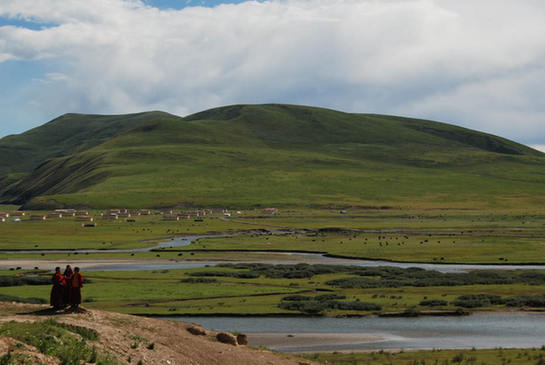| Tales from the Zhaxika Grassland
By WU ZILI
|
 |
| Gers and herds of yaks and sheep adorn the lush Zhaxika Grassland. |
Gers and herds of yaks and sheep adorn the lush Zhaxika Grassland.
THE stretch of steppe on the Qinghai-Tibet Plateau known as Zhaxika – Tibetan for “tribe at the headstream of Yalong River,” straddles Sichuan and Qinghai provinces as well as Tibet Autonomous Region. It was the casual mention in conversation of this area of grassland in Serxu County, Garze Tibetan Autonomous Prefecture, Sichuan Province, that brought me to Zhaxika.
Serxu County is the largest and most outlying county in Sichuan, situated at the northernmost tip and highest altitude of the province. It borders the southern slope of the Bayan Har Mountain Range to its north, the Mola section of the Shaluli Mountain Range to its south and Yushu Prefecture of Qinghai Province to the northwest. The Jinsha River to the southwest flows between Serxu and Jomda County of Tibet Autonomous Region. Southeast Serxu is close to Sertar and Dege counties. Just 1,070 kilometers from Chengdu, capital of Sichuan, Serxu County has an average altitude of 4,000 meters above sea level and covers an area of 25,141 square kilometers, 90 percent of it grassland. As there are few roads, our journey was in three stages. We started out from Beijing for Xi’an, capital of Shaanxi Province, took a flight from there to Yushu, and then drove the remaining 100 kilometers at an altitude of 4,700 meters to Nixia Town, seat of the Serxu County government.
Unadorned Happiness
Transportation, electricity and communications are scant in this remote area. As its economy is undeveloped, it receives few tourists.
Residents of Zhaxika are mainly herders and farmers. They live at the edge of the county, where their yaks and sheep graze on patches of wetlands by a tributary of the Yalong River. Prayer banners flutter in every household yard. We stopped in at one household, where the parents of the family were washing fleece as their children played. They were all very friendly and could speak some Mandarin. The children entertained us with a Tibetan dance.
We also met a young monk sunning himself on the grass. We presumed he must be the eldest son of the family taking care of his younger brothers and sisters. He did not speak Mandarin, so the other children translated for us. When we were about to leave I asked if he would exchange his prayer beads for mine. He smiled and agreed. Back in Beijing, I looked more closely at his beads and saw that he must have worn them for more than a decade, during which time he would have chanted thousands of prayers. This makes them extremely precious to me.
The Hope Primary School in Zhaxika was built on donations, but more money is needed before construction can be completed. It has nonetheless brought hope to Zhaxika residents. Locals celebrated our visit in festival fashion, and were delighted when we took a photo of each pupil. They all hope that one day they will, like urban students, sit in a classroom with desks and blackboards.
| 